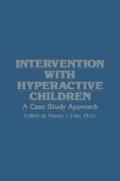Abstract
As discussed in the introductory chapter, the hyperactive child is not defined in isolation from a behavioral setting. The perceptions, beliefs, and expectations of persons in the environment, as well as the nature of the environment itself, have an impact on the identification and course of treatment for hyperactivity. Some environments are more accommodating, and some are considerably less flexible in their adaptation to individual differences among children.
Access this chapter
Tax calculation will be finalised at checkout
Purchases are for personal use only
Preview
Unable to display preview. Download preview PDF.
References
Bugental, D. B. Causal attributions of hyperactive children and motivational assumptions of two behavior-change approaches: Evidence for an interactionist position. Child Dev. 1977, 48:874–884.
Cruickshank, W. M., Bentzen, F. A., Ratezburg, F., and Tannhauser, M. T. A Teaching Method for Brain-Injured and Hyperactive Children. Syracuse: Syracuse University Press, 1961.
Flynn, N. M. and Rapoport, R. Hyperactivity in open and traditional classroom environments. J. Spec. Ed. 1976, 10:285–290.
Koester, L. S. Arousal and hyperactivity in open and traditional education: A test of theory. Dissertation Abstracts. 1977, 37:5203A-5704A.
Krippner, S. An alternative to drug treatment for hyperactive children. Acad. Ther. 1975, 10:433–439.
Meichenbaum, D. and Goodman, J. Training impulsive children to talk to themselves: A means of developing self-control. J. Abnorm. Psychol. 1971, 77:115–126.
Rost, K. J. and Charles, D. C. Academic achievement of brain injured and hyperactive children in isolation. Except. Child. 1967, 34:125–126.
Shores, R. E. and Havbrich, P. A. Effect of cubicles in educating emotionally disturbed children. Except. Child. 1969, 36:21–24.
Somervill, J. W., Warnberg, L. S., and Bost, D. E. Effects of cubicles versus increased stimulation on task performance by first-grade males perceived as distractible and nondistractible. J. Spec. Ed. 1970, 7:169–185.
Zentall, S. S. Envkonmental stimulation model. Except. Child. 1977, 43:502–510.
Zentall, S. S. and Zentall, T. R. Activity and task performance of hyperactive children as a function of environmental stimulation. J. Consulting and Clin. Psychol. 1976, 44:693–697
Reference
Abidin, R. A psychosocial look at consultation and behavior modification. Psychol, in the Schools. 1972, 9(4):358–364.
Bardon, J. I. Mental health education: A framework for psychological services in the schools. J. School Psychol. 1963, 1:20–27.
Caplan, G. Types of mental health consultation. Amer. J. Orthopsychiat. 1963, 33: 470–481.
Caplan, G. Principles of Preventive Psychiatry. New York: Basic Books, 1970.
Caplan, G. The Theory and Practice of Mental Health Consultation. New York: Basic Books, 1970.
Dinkmeyer, D. and Carlson, J. (eds.). Consultation: A Book of Readings. New York: John Wiley, 1975.
Fine, M. (ed.). Principles and Techniques of Intervention with Hyperactive Children. Springfield, 111.: Charles C Thomas, 1977.
Fine, M. and Tyler, M. Concerns and directions in teacher consultation. J. School Psychol. 1971, 9:436–444.
Gray, S. W. The Psychologist in the Schools. New York: Holt, Rinehart, & Winston, 1963.
Grieger, R. Teacher attitudes as a variable in behavior modification consultation. J. School Psychol. 1972, 10:279–287.
Kaplan, M. and Sprunger, B. Psychological evaluations and teacher perception of students. J. School Psychol. 1967, 5:287–291.
Lippnr, G. L. The consultative process. The School Psychol. 1967, 21:72–74.
Losen, S. M. The school psychologist-psychotherapist or consultant. Psychol, in the Schools 1964, 1:13–17.
Meyers, J., Preroman, M., and Gaughan, E., Jr. The effects of consultee-centered consultation on teacher behavior. Psychol, in the Schools. 1975, 12(3): 288–295.
Meyers, J., Martin, R., and Hyman, I. (eds.). School Consultation: Readings About Preventive Techniques for Pupil Personnel Workers. Springfield, III.: Charles C Thomas, 1977.
Newman, R. G. Psychological Consultation in the Schools. New York: Basic Books, 1967.
Parker, C. (ed.). Psychological Consultation: Helping Teachers Meet Special Needs. Reston, Va.: Council for Exceptional Children, 1975.
Renshaw, S. The Hyperactive Child. Chicago: Nelson-Hall, 1974.
Rogers, C. R. Significant learning: In therapy and education. Educa, Leadership 1959, 16:232–242.
Ross, D. M. and Ross, S. A. Hyperactivity: Research, Theory and Action. New York: John Wiley, 1976.
Tyler, M. and Fine, M. J. The effects of limited and intensive school psychologist- teacher consultation. J, School Psychol. 1974, 12:8–16.
Valett, R. E. The Psychoeducational Treatment of Hyperactive Children. Belmont, Ca.: Fearon Publishers, 1974.
Rights and permissions
Copyright information
© 1980 Spectrum Publications, Inc.
About this chapter
Cite this chapter
Thompson, B.J., Peterson, N.L., DeMers, S., Burke, J.P. (1980). Ecological Considerations. In: Intervention with Hyperactive Children. Springer, Dordrecht. https://doi.org/10.1007/978-94-011-6284-5_6
Download citation
DOI: https://doi.org/10.1007/978-94-011-6284-5_6
Publisher Name: Springer, Dordrecht
Print ISBN: 978-94-011-6286-9
Online ISBN: 978-94-011-6284-5
eBook Packages: Springer Book Archive

